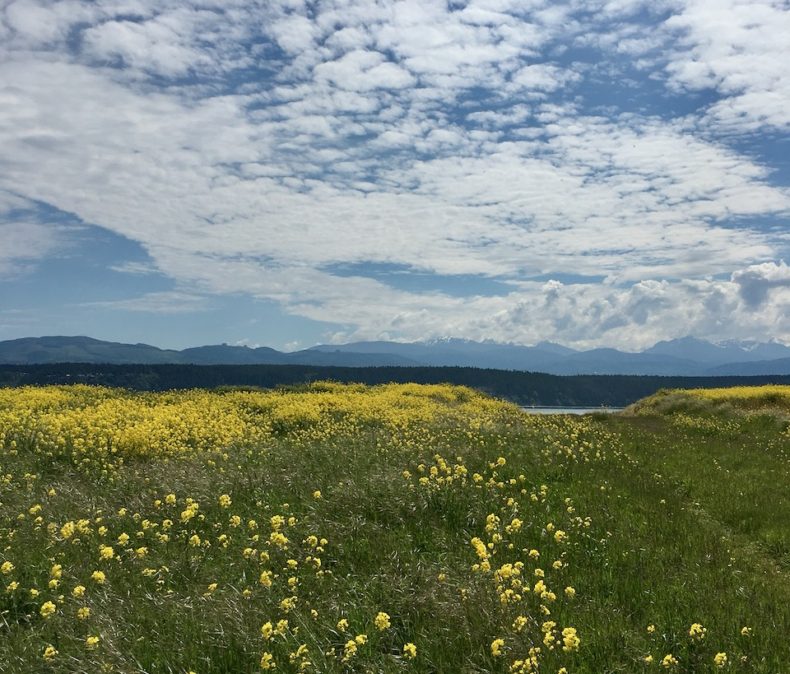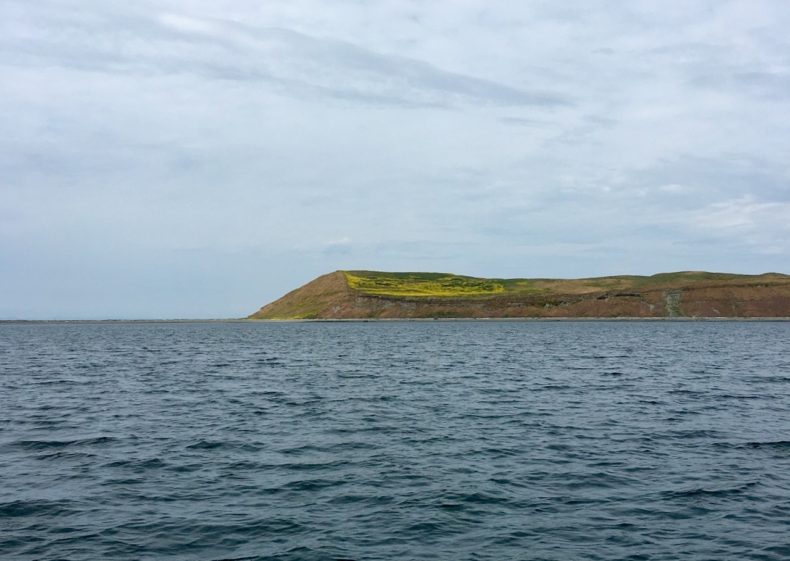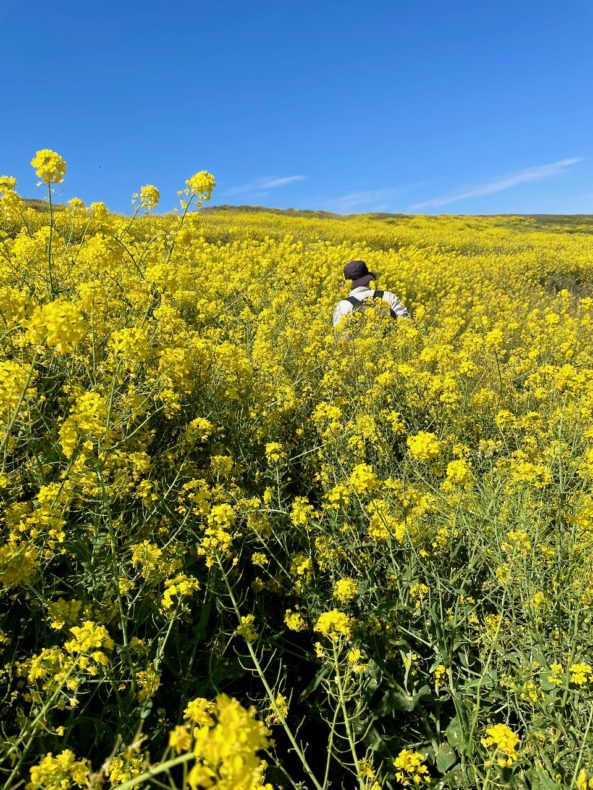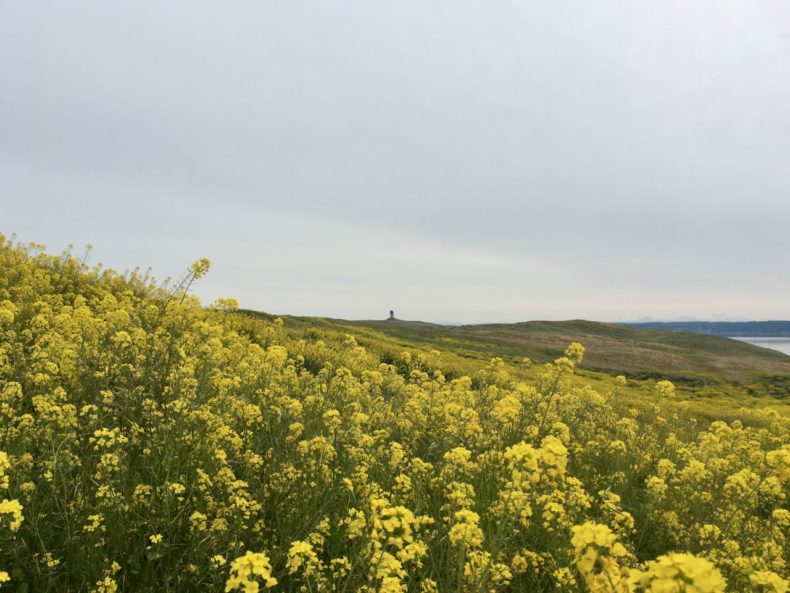
The fire started on the west side of Protection Island, on a spit called Kanem Point. A witness later reported seeing a boat near the shore shooting off flares, one of which landed in the driftwood on the beach. Smoke soon billowed up. It was early August so all the grass that covers the island was dead, and the fire reached the steep bluffs. Flames licked up their sides to the island’s flat top and spread from there.
Dozens of acres burned before crews were able to contain the fire, but it could have been a lot worse. The wind was from the east that day and held the fire at bay; had the wind been from the west, the whole island would likely have burned. Also, almost all of the tens of thousands of rhinoceros auklets and pigeon guillemots and glaucous-winged gulls and savannah sparrows that breed on the island had finished, so it is thought that only a few chicks died.
So much—too much—can depend on luck.
The fire, its consequences, its implications—these were all on my mind as I stood in the stern of the R/V Puffin when it motored out last Tuesday from the small town of Sequim, on the north coast of the Olympic Peninsula in Washington. I help monitor the large rhinoceros auklet colony at Protection and this was the first visit of the field season. I’ve been going to Protection for five years, and the first visit for me has always been a deeply satisfying joy: the chance to see the auklets again and be immersed in their world for a time, the renewal of a cycle of renewal, and all that. But this trip had a different tenor. Finally, I thought, I would see for myself what the fire had done.

Protection grew out of the horizon soon after we left the marina. I don’t know what I expected—maybe broad scars of blackened soil, maybe scattered husks of burned shrubs—but that was not what I saw. True, a lot of the driftwood on the beach was black, but it was fronted by a new layer of bleached logs tossed up by winter storms. As for the island itself, it was blotched brown in spots but generally green like it always is, except for its western face, which was bright yellow with mustard flowers. I had never seen such a concentration of mustard.
The boat puttered into the small harbor and, after unloading our gear, five of us split into a couple of teams to go count auklets. I went with Tom Good, a biologist from NOAA, and we set off for our first site, on Protection’s southwestern face. Up close, the mustard was enormous. The stalks were thick and strong, the flower clusters bursting with pollen. Some of the plants were taller than I am; I emerged from one patch dusted in yellow, looking like I’d raced in one of those Color Runs.

All well and good, I thought. So some plants came back, but what of the auklets? How much would they care that their island home had burned? The signs were not promising. Thrashing through the mustard, I had seen at the base of all those stalks dirt that was clearly charred—the island’s flayed skin. Throughout the dirt were the openings to the auklets’ burrows. Normally those openings would be hidden in thick grass, but now they looked naked and exposed and too, too vulnerable, shed of their sense of safety even with the mustard towering over them. The ground felt so fragile; with each step I worried I might blunder onto a tunnel and collapse it.
Tom and I at last reached the site and set down our packs. We use finicky infrared camera probes to check the burrows, snaking them in on long cables. Tom had his and I had mine, and I knelt before the first burrow and turned on the camera. After the grayscale image stabilized in my headset, I stuck the probe into the tunnel and began to maneuver it into the gloomy depths. Rocks and feathers were strewn all over its floor; grass roots hung thickly from the ceiling like shredded curtains. I pushed the camera through them one feet, two feet, three feet, until I came to the place where the tunnel widened, opening into a small chamber.
I coaxed the camera into the chamber and worked the cable, twisting it around and around so the camera would flip, too, allowing me to inspect all the nooks and crannies. There, sitting in the back corner the chamber, its eye gleaming in the infrared light, its egg just visible under its tail, was an auklet. It shifted its weight and retucked its small, strong wings against its body.
Is it too much to say I was relieved? I was relieved. Is it too much to say I was happy? I was happy. Why, hello there, I thought. Welcome back. Then the auklet blinked and inclined its head towards the camera, so I hastily withdrew it, hoping I hadn’t disturbed the bird any more than I had to.

All photos by the author, except for the third (of the author), which is by Tom Good.
I think reading this just dropped my blood pressure by 5 points. It’s absolutely beautiful. Thank you.
This comment dropped my blood pressure by 5 points. Thank _you_!
I treasure the shred of hope this story brings and care with which Eric took in getting it for us.